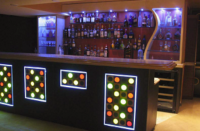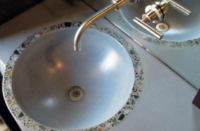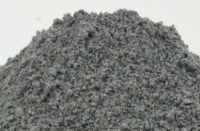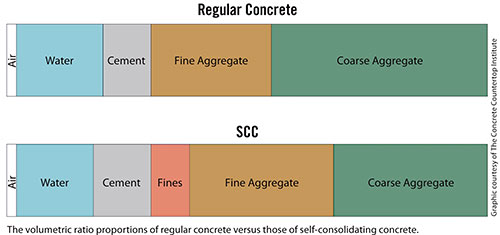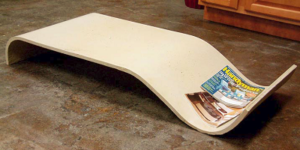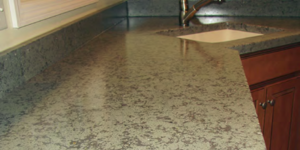Self-consolidating concrete (SCC), also known as self-compacting concrete, is an amazing and special type of concrete that is highly flowable and resists segregation. It combines specialized mix designs with advanced chemical admixtures to achieve a concrete mixture that, under its own weight, can spread through and around dense reinforcements to adequately fill voids without segregation or excessive bleeding and without the need for significant vibration which is perfect for concrete countertops. In the decorative concrete arena, it has been used to produce castings with a high surface quality, often with few or no pinholes. Less labor, quicker casting times, better surface finish and increased concrete densities are common reasons for choosing Self-consolidating concrete for concrete countertops.
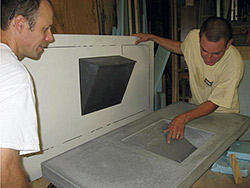
The key properties of Self-consolidating concrete are its filling ability, passing ability and resistance to segregation.
“Filling ability” refers to how the mixture flows and spreads on its own.
“Passing ability” refers to how the coarse aggregate passes through congested reinforcing.
“Segregation” is the settling and separation of the aggregate from the cement paste.
Achieving a concrete mixture that is both extremely workable and also resists segregation is challenging and requires a systematic approach that encompasses ingredient selection, mix design and testing.
Before getting into what makes Self-consolidating concrete, let’s first look at ordinary concrete for comparison.
Normal concrete mix designs tend to be aggregate-rich and cement-lean. The cement content is usually only 6 sacks per cubic yard, which translates into 564 pounds of cement in about 3,800 pounds of concrete. And typical water-to-cement ratios often range from 0.40 to 0.60.
SCC is different. It uses less coarse aggregate and more cement and cement-sized filler material. Cement content sometimes exceeds 8 or 9 sacks per cubic yard. Typical water-to-cement ratios are often below 0.4. This makes these mixes dense and very strong, with compressive strengths commonly greater than 6,000 psi.
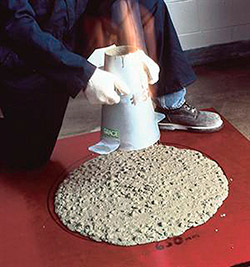
Normal concrete requires various degrees of effort to move, spread, level and consolidate. Workability is commonly measured using a slump cone, where the slump index measures the vertical deformation of an unsupported cone of fresh concrete. In contrast, the high flowability of SCC is measured in terms of spread instead of slump, because the material flows so readily. The ASTM slump flow test is similar to a standard ASTM slump test, but instead of measuring a vertical height change, a horizontal spread measurement is made instead; typical spread values range from about 20 to 30 inches.
 Normal concrete’s workability is usually enhanced by adding water or, preferably, adding a water reducer or superplasticizer. However this only goes so far. Adding too much water or too much superplasticizer will cause segregation and could also affect setting time and early strength gain.
Normal concrete’s workability is usually enhanced by adding water or, preferably, adding a water reducer or superplasticizer. However this only goes so far. Adding too much water or too much superplasticizer will cause segregation and could also affect setting time and early strength gain.
In contrast, self-consolidating concrete starts with a purposeful mix design that has proportionally less coarse aggregate, a low water-to-cement ratio, more cement and very fine material. Ordinarily such a mix would be difficult to work with, but the use of advanced superplasticizers transforms the stiff, nonworkable mixture into a highly flowable (or deformable, in the technical parlance) mix that self-spreads and compacts easily all on its own. Control of segregation comes first from the mix design and then from the use of viscosity-modifying admixtures (VMAs). This combination prevents aggregate separation and cement cream bleeding.

Why SCC is extraordinary
What’s important to realize is that SCC is not simply ordinary concrete that has a stronger superplasticizer added to it. SCC is a system that’s designed from the ground up to achieve characteristics ordinary concrete cannot attain. Making highly flowable concrete that resists segregation requires a delicate balance between careful mix design, proper admixture selection and dosage. It depends upon a care and awareness by all those involved in the design, mixing and placing.
Excess moisture in the ingredients, especially the fine aggregates, can have a profound influence on the consistency of the mix. Small fluctuations in moisture content may lead to segregation or affect the mix’s ability to flow. Variations in aggregate gradation from batch to batch can cause consistency problems.
VMAs help compensate for variations in aggregate gradations and can moderate variations in moisture content. But even with VMAs, SCC is very sensitive to changes in moisture content. Adding water will make it more fluid but will also cause the mix to segregate. Field adjustments must be made carefully by experienced personnel. The common practice of adding water to the mix truck is too crude and will most likely ruin an SCC mix.
SCC contains large amounts of fine material, which generally means there will be little or no bleed water. If SCC is used for flatwork, additional precautions must be taken to prevent the surface from drying out and developing plastic shrinkage cracks.
Vertical forms must be made watertight and braced to resist full head pressure from the concrete. SCC stays fluid longer than normal concrete, so forms must be filled at an appropriate pace.
